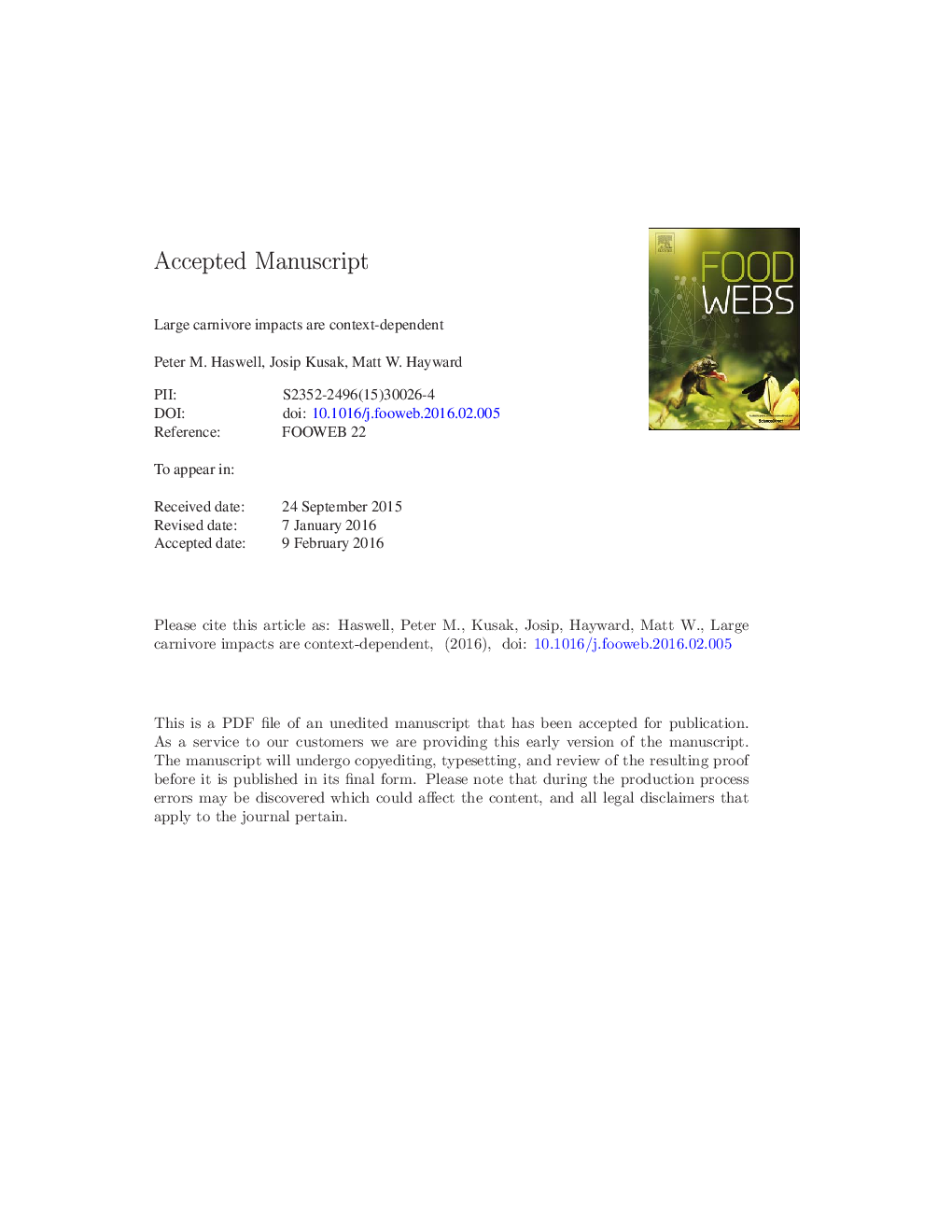| کد مقاله | کد نشریه | سال انتشار | مقاله انگلیسی | نسخه تمام متن |
|---|---|---|---|---|
| 5759817 | 1623633 | 2017 | 31 صفحه PDF | دانلود رایگان |
عنوان انگلیسی مقاله ISI
Large carnivore impacts are context-dependent
ترجمه فارسی عنوان
تاثیرات گوشت خوار بزرگ وابسته به زمینه است
دانلود مقاله + سفارش ترجمه
دانلود مقاله ISI انگلیسی
رایگان برای ایرانیان
کلمات کلیدی
ترجمه چکیده
تعاملات بین گوشتخواران بزرگ و گونه های دیگر ممکن است مسئول اثرات ناشی از تراکم آنها نسبتا زیاد باشد. تعاملات وابسته به طبیعت بین گونه ها رایج است، اما اغلب نامناسب است. احتیاط باید در نظر گرفتن شکارچیان اره به عنوان ناجی های اکولوژیک بیان شود، زیرا خدمات اکوسیستم ممکن است به طور جهانی اعمال نشود، به خصوص اگر توسط فعالیت های انسان شناسی مهار شود. این بررسی چگونگی اثرگذاری گوشتخواران بزرگ را در چهار زمینه اصلی (جمع آوری گونه ها، بهره وری محیطی، چشم انداز، خطر شکار) و توانایی دخالت انسان در تأثیر بر این زمینه بررسی می کند. انسان ها چشم انداز غالب و کاربر منابع در این سیاره هستند و مداخله مدیریت ما بر ترکیب گونه ها، دسترسی به منابع، جمعیت شناسی، رفتار و پویایی تنوع بین گونه ای تاثیر می گذارد. انسانها می توانند به شیوه های مختلف گوشتخواران تاثیر بگذارد و این شکارچیان صخره ای به مزوپرادورها و گونه های شکار حمله می کنند - از طریق روش های تراکم متخلخل (مصرفی) و شیوه / رفتاری (بدون مصرف). تعصب بین دوزیست و سرکوب یا آزادی بزرگ گیاهخوار، رقابت درونزا و فشار روانی، ممکن است تحت تاثیر شرایط انسان قرار گیرد. هدف بازگرداندن سیستم های "طبیعی" تا حدودی مشکل است و همیشه عملی نیست. تعاملات متقابل از طریق زمینه تحت تاثیر قرار می گیرند، و انسان ها اغلب راننده غالب در شکل گیری زمینه هستند. اگر اهداف مدیریت و حفاظت از اهداف در نظر گرفته شود، مهم است بدانیم چگونه انسان ها بر تعاملات طوفیک تاثیر می گذارند و چگونه تعاملات طوفان تحت تاثیر قرار می گیرند. اگر پیچیدگی های شبکه های غذایی به درستی درک شود، مداخلات مداخله و مداخلات تنها می تواند موفقیت آمیز باشد.
موضوعات مرتبط
علوم زیستی و بیوفناوری
علوم کشاورزی و بیولوژیک
علوم کشاورزی و بیولوژیک (عمومی)
چکیده انگلیسی
Interactions between large carnivores and other species may be responsible for impacts that are disproportionately large relative to their density. Context-dependent interactions between species are common but often poorly described. Caution must be expressed in seeing apex predators as ecological saviours because ecosystem services may not universally apply, particularly if inhibited by anthropogenic activity. This review examines how the impacts of large carnivores are affected by four major contexts (species assemblage, environmental productivity, landscape, predation risk) and the potential for human interference to affect these contexts. Humans are the most dominant landscape and resource user on the planet and our management intervention affects species composition, resource availability, demography, behaviour and interspecific trophic dynamics. Humans can impact large carnivores in much the same way these apex predators impact mesopredators and prey species - through density-mediated (consumptive) and trait/behaviourally-mediated (non-consumptive) pathways. Mesopredator and large herbivore suppression or release, intraguild competition and predation pressure may all be affected by human context. The aim of restoring 'natural' systems is somewhat problematic and not always pragmatic. Interspecific interactions are influenced by context, and humans are often the dominant driver in forming context. If management and conservation goals are to be achieved then it is pivotal to understand how humans influence trophic interactions and how trophic interactions are affected by context. Trade-offs and management interventions can only be implemented successfully if the intricacies of food webs are properly understood.
ناشر
Database: Elsevier - ScienceDirect (ساینس دایرکت)
Journal: Food Webs - Volume 12, September 2017, Pages 3-13
Journal: Food Webs - Volume 12, September 2017, Pages 3-13
نویسندگان
Peter M. Haswell, Josip Kusak, Matt W. Hayward,
